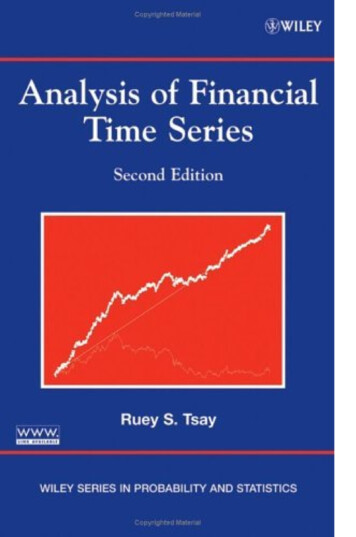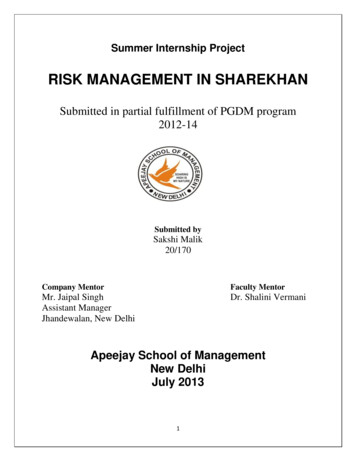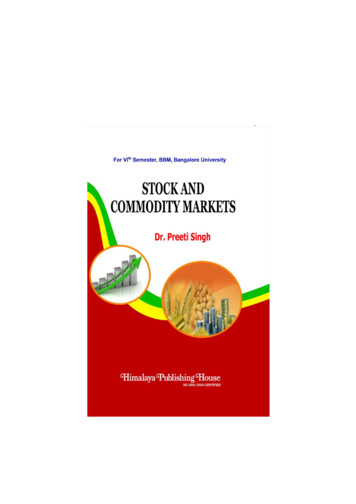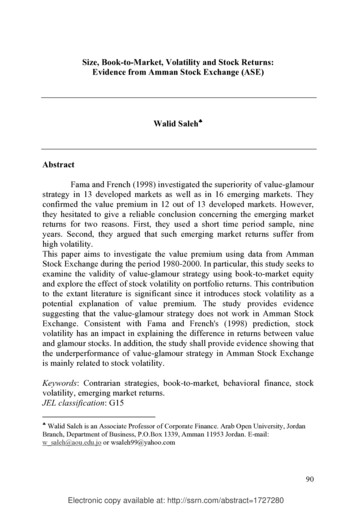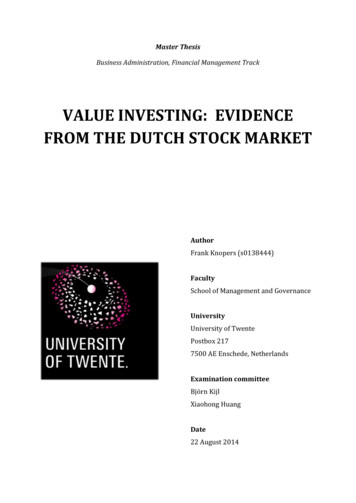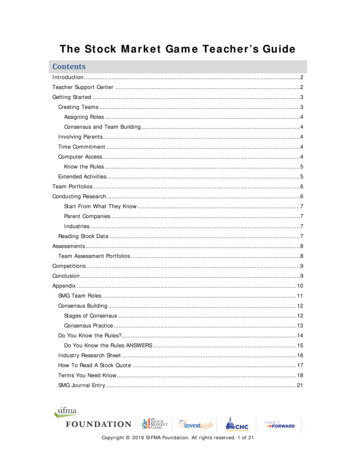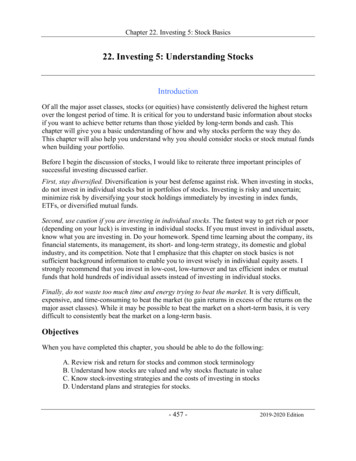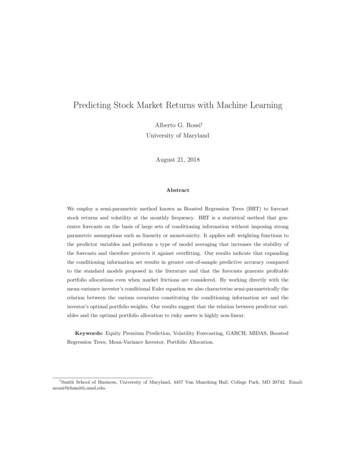
Transcription
Predicting Stock Market Returns with Machine LearningAlberto G. Rossi†University of MarylandAugust 21, 2018AbstractWe employ a semi-parametric method known as Boosted Regression Trees (BRT) to forecaststock returns and volatility at the monthly frequency. BRT is a statistical method that generates forecasts on the basis of large sets of conditioning information without imposing strongparametric assumptions such as linearity or monotonicity. It applies soft weighting functions tothe predictor variables and performs a type of model averaging that increases the stability ofthe forecasts and therefore protects it against overfitting. Our results indicate that expandingthe conditioning information set results in greater out-of-sample predictive accuracy comparedto the standard models proposed in the literature and that the forecasts generate profitableportfolio allocations even when market frictions are considered. By working directly with themean-variance investor’s conditional Euler equation we also characterize semi-parametrically therelation between the various covariates constituting the conditioning information set and theinvestor’s optimal portfolio weights. Our results suggest that the relation between predictor variables and the optimal portfolio allocation to risky assets is highly non-linear.Keywords: Equity Premium Prediction, Volatility Forecasting, GARCH, MIDAS, BoostedRegression Trees, Mean-Variance Investor, Portfolio Allocation.†Smith School of Business, University of Maryland, 4457 Van Munching Hall, College Park, MD 20742. Email:arossi@rhsmith.umd.edu.
1IntroductionInformation plays a central role in modern finance. Investors are exposed to an ever-increasingamount of new facts, data and statistics every minute of the day. Assessing the predictability of stock returns requires formulating equity premium forecasts on the basis of large sets ofconditioning information, but conventional statistical methods fail in such circumstances. Nonparametric methods face the so-called “curse-of-dimensionality”. Parametric methods are oftenunduly restrictive in terms of functional form specification and are subject to data overfittingconcerns as the number of parameters estimated increases. The common practice is to use linear models and reduce the dimensionality of the forecasting problem by way of model selectionand/or data reduction techniques. But these methods exclude large portions of the conditioninginformation set and therefore potentially reduce the accuracy of the forecasts. To overcome theselimitations we employ a novel semi-parametric statistical method known as Boosted RegressionTrees (BRT). BRT generates forecasts on the basis of large sets of conditioning variables withoutimposing strong parametric assumptions such as linearity or monotonicity. It does not overfitbecause it performs a type of model combination that features elements such as shrinkage andsubsampling. Our forecasts outperform those generated by established benchmark models interms of both mean squared error and directional accuracy. They also generate profitable portfolio allocations for mean-variance investors even when market frictions are accounted for. Ouranalysis also shows that the relation between the predictor variables constituting the conditioninginformation set and the investors’ optimal portfolio allocation to risky assets is, in most cases,non-linear and non-monotonic.Our paper contributes to the long-standing literature assessing the predictability of stock returns. Over the nineties and the beginning of the twenty-first century the combination of longertime-series and greater statistical sophistication have spurred a large number of attempts to addevidence for or against the predictability of asset returns and volatility. In-sample statisticaltests show a high degree of predictability for a number of variables: Roze (1984), Fama andFrench (1988), Campbell and Shiller (1988a,b), Kothari and Shanken (1997) and Ponti andSchall (1998) find that valuation ratios predict stock returns, particularly so at long horizons;Fama and Schwert (1977), Keim and Stambaugh (1986), Campbell (1987), Fama and French(1989), Hodrick (1992) show that short and long-term treasury and corporate bonds explainvariations in stock returns; Lamont (1998), Baker and Wurgler (2000) show that variables related to aggregate corporate payout and financing activity are useful predictors as well. Whilethese results are generally encouraging, there are a number of doubts regarding their accuracyas most of the regressors considered are very persistent, making statistical inference less thanstraightforward; see, for example, Nelson and Kim (1993), Stambaugh (1999), Campbell and1
Yogo (2006) and Lewellen, Nagel, and Shanken (2010). Furthermore, data snooping may be asource of concern if researchers are testing for many di erent model specifications and reportonly the statistically significant ones; see, for example, Lo and MacKinlay (1990), Bossaerts andHillion (1999) and Sullivan, Timmermann, and White (1999). While it is sometimes possible tocorrect for specific biases, no procedure can o er full resolution of the shortcomings that a ectthe in-sample estimates.Due to the limitations associated with in-sample analyses, a growing body of literature hasargued that out-of-sample tests should be employed instead; see, for example, Pesaran and Timmermann (1995, 2000), Bossaerts and Hillion (1999), Marquering and Verbeek (2005), Campbelland Thompson (2008), Goyal and Welch (2003) and Welch and Goyal (2008). There are at leasttwo reasons why out-of-sample results may be preferable to in-sample ones. The first is that eventhough data snooping biases can be present in out-of-sample tests, they are much less severe thantheir in-sample counterparts. The second is that out-of-sample tests facilitate the assessment ofwhether return predictability could be exploited by investors in real time, therefore providing anatural setup to assess the economic value of predictability.The results arising from the out-of-sample studies are mixed and depend heavily on the modelspecification and the conditioning variables employed.1 In particular, many of the studies conducted so far are characterized by one or more of these limitations. First, the forecasts aregenerally formulated using simple linear regressions. The choice is dictated by simplicity and theimplicit belief that common functional relations can be approximated reasonably well by linearones.2 Most asset pricing theories underlying the empirical tests, however, do not imply linearrelationships between the equity premium and the predictor variables, raising the issue whetherthe mis-specification implied by linear regressions is economically large. Second, linear models overfit the training dataset and generalize poorly out-of-sample as the number of regressorsincreases, so parsimonious models need to be employed at the risk of discarding valuable conditioning information. Approaching the forecasting exercise by way of standard non-parametricor semi-parametric methods is generally not a viable option because these methods encounter“curse-of-dimensionality” problems rather quickly as the size of the conditioning information setincreases. Third, the models tested are generally constant: di erent model specifications areproposed and their performance is assessed ex-post. Although interesting from an econometricperspective, these findings are of little help for an investor interested in exploiting the condition1The data frequency also a ects the results. Stock returns are found to be more predictable at quarterly, annualor longer horizons, while returns at the monthly frequency are generally considered the most challenging to predict.2Another reason underlying the use of linear frameworks is that those statistical techniques were known by investorssince the beginning of the twentieth century. For this and other issues related to “real-time” forecasts, see Pesaranand Timmermann (2005).2
ing information in real time as he would not know what model to choose ex-ante.3 Finally, apartfrom some important exceptions, much of the literature on financial markets prediction focuseson formulating return forecasts and little attention is dedicated to analyzing quantitatively theeconomic value associated with them for a representative investor.4While conditional returns are a key element needed by risk-averse investors to formulate assetallocations, the conditional second moments of the return distribution are crucial as well. In fact,they are the only two pieces of information required by a mean-variance investor to formulateoptimal portfolio allocations. It is widely known that stock market volatility is predictableand a number of studies attempts to identify which macroeconomic and financial time-series canimprove volatility forecasts at the monthly or longer horizons.5 But it is still unclear whether thatconditioning information could have been incorporated in real-time and how much an investorwould have benefitted from it.In this paper we consider a representative mean-variance investor that exploits publicly available information to formulate excess returns and volatility forecasts using Boosted RegressionTrees (BRT). BRT finds its origin in the machine learning literature, it has been studied extensively in the statistical literature and has been employed in the field of financial economics byRossi and Timmermann (2010) to study the relation between risk and return. The appeal ofthis method lies in its forecasting accuracy as well as its ability to handle high dimensional forecasting problems without overfitting. These features are particularly desirable in this context,because they allow us to condition our forecasts on all the major conditioning variables thathave been considered so far in the literature, guaranteeing that our analysis is virtually free ofdata-snooping biases. BRT also provide a natural framework to assess the relative importanceof the various predictors at forecasting excess returns and volatility. Finally, the method allowsfor semi-parametric estimates of the functional form linking predictor and predicted variables,giving important insights on the limitations of linear regression.Our analysis answers three questions. The first is whether macroeconomic and financialvariables contain information about expected stock returns and volatility that can be exploited inreal time by a mean-variance investor. For stock returns we use the major conditioning variablesproposed so far in the literature and summarized by Welch and Goyal (2008). We propose twomodels of volatility forecasts. The first models volatility as a function of monthly macroeconomicand financial time-series as well as past volatility. The second is inspired by the family of MIDASmodels proposed by Ghysels, Santa-Clara, and Valkanov (2006) and models monthly volatility3For exceptions, see Dangl and Halling (2008) and Johannes, Korteweg, and Polson (2009).For exceptions, see Campbell and Thompson (2008) and Marquering and Verbeek (2005).5See, for example, Campbell (1988), Breen, Glosten, and Jagannathan (1989), Marquering and Verbeek (2005),Engle and Rangel (2005) and Engle, Ghysels, and Sohn (2006), Lettau and Ludvigson (2009) and Paye (2010).43
as a function of lagged daily squared returns. We call this model “semi-parametric MIDAS”and show that its performance is superior to that of its parametric counterpart. Genuine outof-sample forecasts require not only that the parameters are estimated recursively, but also thatthe conditioning information employed is selected in real-time. For this reason, every predictiveframework under consideration starts from the large set of predictor variables employed by Welchand Goyal (2008) and selects recursively the model specification. Our estimates show that BRTforecasts outperform the established benchmarks and possess significant market timing in bothreturns and volatility.A related question we address is whether the conditioning information contained in macro andfinancial time-series can be exploited to select the optimal portfolio weights directly, as proposedby Ait-Sahalia and Brandt (2001). Rather than forecasting stock returns and volatility separatelyand computing optimal portfolio allocations in two separate steps, we model directly the optimalportfolio allocation as a target variable. Our approach can be interpreted as the semi-parametriccounterpart of Ait-Sahalia and Brandt (2001),6 because instead of reducing the dimensionalityof the problem faced by the investor using a single index model, we employ a semi-parametricmethod that avoids the so-called “curse of dimensionality”. Our analysis gives rise to two findings.First, formal tests of portfolio allocation predictability show that optimal portfolio weights aretime-varying and forecastable; second, we show that the relation between the predictor variablesconstituting the conditioning information set and the mean-variance investor’s optimal portfolioallocation to risky assets is highly non-linear.The third question we analyze is whether the generated forecasts are economically valuablein terms of the profitability of the portfolio allocations they imply. We assess this by computing excess returns, Sharpe ratios and Treynor-Mazuy market timing tests for the competinginvestment strategies. Our results highlight that BRT forecasts translate into profitable portfolioallocations. We also compute the realized utilities and the break-even monthly portfolio fees thata representative agent would be willing to pay to have his wealth invested through the strategieswe propose, compared to the benchmark of placing 100% of his wealth in the market portfolio.We show that the break-even portfolio fees are sizable even when transaction costs as well asshortselling and borrowing constraints are considered. For example, a representative investorwith a risk-aversion coefficient of 4 who faces short-selling and borrowing constraints as well astransaction costs would be willing to pay yearly fees equal to 4% of his wealth to have his capitalinvested in the investment strategy we propose rather than the market portfolio.The rest of the paper is organized as follows. Section 2 introduces our empirical frameworkand describes how stock returns and volatility are predicted. In Section 3 we show how we employ6It is important to clarify that our analysis applies only to the mean-variance investor, while Ait-Sahalia and Brandt(2001) work with power utility investors as well.4
boosted regression trees to directly select optimal portfolio allocations. Section 4 presents resultsfor the out-of-sample accuracy of the model, conducts formal tests of market timing in bothreturns and volatility and evaluates the performance of empirical trading strategies based onBRT forecasts. Section 5 concludes.2Empirical Framework and Full-Sample ResultsConsider a representative agent that has access to a risk-free asset paying a return of rf,t 1 andthe market portfolio with a return rt 1 and volatilityt 1 .The agent’s utility function is a ectedonly by the first and second moments of the returns distribution, i.e. his utility function takesthe form1V art {rp,t 1 },2(1)is the coefficient of risk-aversion, rp,t 1 wt 1 t rt 1 (1wt 1 t ) (rf,t 1 ) and wt 1 tUt (·) Et {rp,t 1 }whereis the proportion of wealth allocated to the risky asset for period t 1 given the informationavailable as of time t. Given the expected returns and volatility of the market portfolio, theinvestor chooses his asset allocation by solving the maximization problemmaxwt 1 t Et wt 1 t rt 1 (11V art wt 1 t rt 1 (12wt 1 t ) rf,t 1wt 1 t ) rf,t 1,leading to the optimal portfolio weights wt 1 t Et {rt 1 } rf,t 1.V art {rt 1 }(2)When we impose realistic short-selling and borrowing constraints, the optimal weights have tolie between 0 and 1, so they becomerwt 1 t8 0 wt 1 t :1 wt 1 t 0,ifif 10 wt 1 t wt 1 t 1.ifThe objects Et {rt 1 } µt 1 t and V art {rt 1 } 2t 1 tin Eq. 2 represent conditional expec-tations of returns and variance on the basis of the investor’s conditioning information at timet. In this paper we allow these conditional expectations to be non-linear functions of observablemacroeconomic and financial time-series, the idea being that the linearity assumption gener-5
ally adopted in financial economics may be costly in terms of forecasting accuracy and portfolioallocation profitability.The conditioning information we use are the twelve predictor variables previously analyzedin Welch and Goyal (2008) and by many others subsequently. Stock returns are tracked bythe S&P 500 index and include dividends. A short T-bill rate is subtracted to obtain excessreturns. The predictor variables from the Goyal and Welch analysis are available during 19272005 and we extend their sample up to the end of 2008.7 The predictor variables pertain tothree large categories. The first goes under the heading of “risk and return” and contains laggedreturns (exc), long-term bond returns (ltr) and volatility (vol). The second, called “fundamentalto market value” includes the log dividend-price ratio (dp) and the log earnings-price ratio(ep). The third category comprises measures of interest rate term structure and default riskand includes the three-month T-bill rate (Rfree), the T-bill rate minus a three-month movingaverage (rrel), the yield on long term government bonds (lty), the term spread measured bythe di erence between the yield on long-term government bonds and the three-month T-billrate (tms) and the yield spread between BAA and AAA rated corporate bonds (defspr). We alsoinclude inflation (infl) and the log dividend-earnings ratio (de). Additional details on data sourcesand the construction of these variables are provided by Welch and Goyal (2008). All predictorvariables are appropriately lagged so they are known at time t for purposes of forecasting returnsin period t 1.For stock returns, conditional expectations are commonly generated according to the followinglinear model0µ xt ,µbt 1 t where xt represents a set of publicly available predictor variables andµis a vector of parameterestimates obtained via ordinary least squares. The linear specification is generally imposed forsimplicity at the expense of being potentially misspecified. The sources of misspecification areat least two. The first relates to what information is incorporated in the formulation of theforecasts. Asset pricing models suggest a wide array of economic state variables for both returnsand volatility, but linear frameworks are prone to over-fitting if the number of parameters tobe estimated is large compared to the number of observations, forcing the agent to exclude alarge portion of the conditioning information available. The second relates to how information isincorporated in the forecasts: theoretical frameworks rarely identify linear relations between the7We are grateful to Amit Goyal and Ivo Welch for providing this data. A few variables were excluded from theanalysis since they were not available up to 2008, including net equity expansion and the book-to-market ratio. Wealso excluded the CAY variable since this is only available quarterly since 1952.6
variables at hand, so empirical estimates based on ordinary least squares may not be appropriate.Note however that, in our context, misspecification per se is not a source of concern as long as itdoes not translate into lower predictive accuracy, which is ultimately what matters for portfolioallocation.To address this issue, we extend the basic linear regression model to a class of more flexiblemodels known as Boosted Regression Trees. These have been developed in the machine learningliterature and can be used to extract information about the relationship between the predictorvariables xt and rt 1 based only on their joint empirical distribution. To get intuition for howregression trees work and explain why we use them in our analysis, consider the situation witha continuous dependent variable Y (e.g., stock returns) and two predictor variables X1 and X2(e.g., the volatility and the default spread). The functional form of the forecasting model mappingX1 and X2 into Yt is unlikely to be known, so we simply partition the sample support of X1 andX2 into a set of regions or “states” and assume that the dependent variable is constant withineach partition.More specifically, by limiting ourselves to lines that are parallel to the axes tracking X1 andX2 and by using only recursive binary partitions, we carve out the state space spanned by thepredictor variables. We first split the sample support into two states and model the response bythe mean of Y in each state. We choose the state variable (X1 or X2 ) and the split point toachieve the best fit. Next, one or both of these states is split into two additional states. Theprocess continues until some stopping criterion is reached. Boosted regression trees are additiveexpansions of regression trees, where each tree is fitted on the residuals of the previous tree. Thenumber of trees used in the summation is also known as the number of boosting iterations.This approach is illustrated in Figure 1, where we show boosted regression trees that use twostate variables, namely the lagged values of the default spread and market volatility, to predictexcess returns on the S&P500 portfolio. We use “tree stumps” (trees with only two terminalnodes), so every new boosting iteration generates two additional regions. The graph on the leftuses only three boosting iterations, so the resulting model splits the space spanned by the tworegressors in six regions with one split along the default spread axis and two splits along thevolatility axis. Within each state the predicted value of stock returns is constant. The predictedvalue of excess returns is smallest for high values of volatility and low values of the default spread,and highest for medium values of volatility and high values of the default spread. So already atthree boosting iterations BRT highlights non-linearities in the functional form relating volatilityand stock returns. With only three boosting iterations the model is quite coarse, but the fitbecomes more refined as the number of boosting iterations increase. To illustrate this we ploton right the fitted values for a BRT model with 5,000 boosting iterations. Now the plot is much7
more smooth, but clear similarities between the two graphs remain.Figure 1 illustrates how boosted regression trees can be used to approximate the relationbetween the dependent and independent variables by means of a series of piece-wise constantfunctions. This approximation is good even in situations where, say, the true relation is linear,provided that sufficiently many boosting iterations are used. Next, we provide a more formaldescription of the methodology and how we implement it in our study.82.1Regression TreesSuppose we have P potential predictor (“state”) variables and a single dependent variable overT observations, i.e. (xt , yt 1 ) for t 1, 2, ., T , with xt (xt1 , xt2 , ., xtp ). As illustrated inFigure 1, fitting a regression tree requires deciding (i) which predictor variables to use to splitthe sample space and (ii) which split points to use. The regression trees we use employ recursivebinary partitions, so the fit of a regression tree can be written as an additive model:f (x) JXj 1cj I{x 2 Sj },(3)where Sj , j 1, ., J are the regions we split the space spanned by the predictor variables into,I{} is an indicator variable and cj is the constant used to model the dependent variable in eachregion. If the L2 norm criterion function is adopted, the optimal constant is ĉj mean(yt 1 xt 2Sj ), while it is ĉj median(yt 1 xt 2 Sj ) for the L1 norm instead.The globally optimal splitting point is difficult to determine, particularly in cases where thenumber of state variables is large. Hence, a sequential greedy algorithm is employed. Using thefull set of data, the algorithm considers a splitting variable p and a split point s so as to constructhalf-planesS1 (p, s) {X Xp s}S2 (p, s) {X Xp s}andthat minimize the sum of squared residuals:2min 4minp,sc1X(yt 12c1 ) minc2xt 2S1 (p,s)Xxt 2S2 (p,s)(yt 1c2 )325.(4)8Our description draws on Hastie, Tibshirani, and Friedman (2009) and Rossi and Timmermann (2010) who providea more in-depth coverage of the approach.8
For a given choice of p and s the fitted values, ĉ1 and ĉ2 , arebc1bc2 PTt 1 PTt 11I{xt 2 S1 (p, s)}1I{xt 2 S2 (p, s)}TXt 1TXt 1yt 1 I{xt 2 S1 (p, s)},yt 1 I{xt 2 S2 (p, s)}.(5)The best splitting pair (p, s) in the first iteration can be determined by searching througheach of the predictor variables, p 1, ., P . Given the best partition from the first step, the datais then partitioned into two additional states and the splitting process is repeated for each ofthe subsequent partitions. Predictor variables that are never used to split the sample space donot influence the fit of the model, so the choice of splitting variable e ectively performs variableselection.Regression trees are generally employed in high-dimensional datasets where the relation between predictor and predicted variables is potentially non-linear. This becomes important whenmodeling stock returns because numerous predictor variables have been proposed so far in theliterature. Furthermore, the theoretical frameworks rarely imply a linear or monotonic relationbetween predictor and predicted variable. On the other hand, the approach is sequential andsuccessive splits are performed on fewer and fewer observations, increasing the risk of fittingidiosyncratic data patterns. Furthermore, there is no guarantee that the sequential splittingalgorithm leads to the globally optimal solution. To deal with these problems, we next considera method known as boosting.2.2BoostingBoosting is based on the idea that combining a series of simple prediction models can lead tomore accurate forecasts than those available from any individual model. Boosting algorithmsiteratively re-weight data used in the initial fit by adding new trees in a way that increases theweight on observations modeled poorly by the existing collection of trees. From above, recallthat a regression tree can be written as:T x; {Sj , cj }Jj 1 JXj 1cj I{x 2 Sj }(6)A boosted regression tree is simply the sum of regression trees:fB (x) BXb 1Tb x; {Sb,j , cb,j }Jj 1 ,9(7)
where Tb x; {Sb,j , cb,j }Jj 1 is the regression tree used in the b-th boosting iteration and B is thenumber of boosting iterations. Given the model fitted up to the (bfb1 (x),1)th boosting iteration,the subsequent boosting iteration seeks to find parameters {Sj,b , cj,b }Jj 1 for the nexttree to solve a problem of the form{Ŝj,b , ĉj,b }Jj 1 min{Sj,b , cj,b }Jj 1TX1t 0 yt 1fb1 (xt ) Tb xt ; {Sj,b , cj,b }Jj 1 2.(8)For a given set of state definitions (“splits”), Sj,b , j 1, ., J, the optimal constants, cj,b , in eachstate are derived iteratively from the solution to the problemĉj,b where et 1,bcj,bmincj,bX[yt 1(fb[et 1,b11 (xt ) cj,b )]2xt 2Sj,bX2cj,b ] ,(9)xt 2Sj,bis the empirical error after b 1 boosting iterations. The solutionPTto this is the regression tree that most reduces the average of the squared residuals t 1 e2t 1,b 11 yt 1 fbmin1 (xt )and ĉj,b is the mean of the residuals in the jth state.Forecasts are simple to generate from this approach. The boosted regression tree is firstestimated using data from t 1, ., t . Then the forecast of yt 1 is based on the model estimatesand the value of the predictor variable at time t , xt . Boosting makes it more attractiveto employ small trees (characterized by only two terminal nodes) at each boosting iteration,reducing the risk that the regression trees will overfit. Moreover, by summing over a sequence oftrees, boosting performs a type of model averaging that increases the stability and accuracy ofthe forecasts.92.3ImplementationOur estimations follow the stochastic gradient boosting approach of Friedman (2001) and Friedman (2002) with J 2 nodes. The baseline implementation employs 10,000 boosting iterations,but we conduct a number of robustness checks to show that the results are not very sensitive tothis choice.We adopt three refinements to the basic boosted regression tree methodology. The first isshrinkage. As with ridge regression and neural networks, shrinkage is a simple regularizationtechnique that diminishes the risk of over-fitting by slowing the rate at which the empirical riskis minimized on the training sample. We use a shrinkage parameter, 0 9 1, which determinesSee Rapach, Strauss, and Zhou (2010) for similar results in the context of linear regression.10
how much each boosting iteration contributes to the overall fit:fb (x) fb1 (x)JX j 1Following common practice we setbest empirical strategy is to setcj,b I{x 2 Sj,b }.(10) 0.001 as it has been found (Friedman (2001)) that thevery small and correspondingly increase the number of boostingiterations.The second refinement is subsampling and is inspired by “bootstrap aggregation” (bagging),see Breiman (1996). Bagging is a technique that computes forecasts over bootstrap samples of thedata and averages them in a second step, therefore reducing the variance of the final predictions.In our context, the procedure is adapted as follows: at each boosting iteration we sample withoutreplacement one half of the training sample and fit the next tree on the sub-sample obtained.PTFinally, our empirical analysis minimizes mean absolute errors, i.e. T 1 t 1 yt 1 f (xt ) .Under this criterion function, the optimal forecast is the conditional median of yt 1 rather thanthe conditional mean entailed by squared error loss. We do this in the light of a large literaturewhich suggests that squared-error loss places too much weight on observations with
Predicting Stock Market Returns with Machine Learning Alberto G. Rossi† University of Maryland August 21, 2018 Abstract We employ a semi-parametric method known as Boosted Regression Trees (BRT) to forecast stock returns and volatility at the
